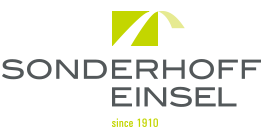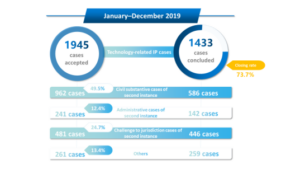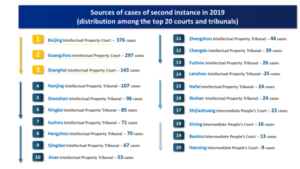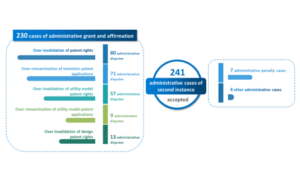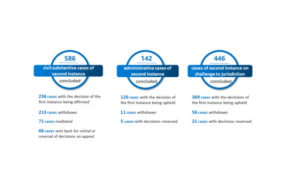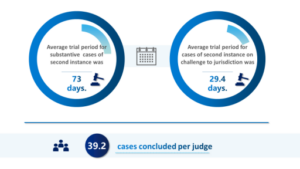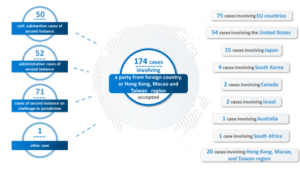Newsletter (May 2020) │ IP Practice
On April 16, 2020, the Supreme People’s Court of China promulgated the “China Intellectual Property Rights Court Annual Report (2019)” (hereinafter referred to as “report”). The Intellectual Property Court of the Supreme People’s Court of China, which was officially launched on January 1, 2019, examined cases of intellectual property rights such as appeals of patents and other technologies, played a role in further unifying the trial standards and improving the quality of trials. The report is a summary of cases heard by the Intellectual Property Court of the Supreme People’s Court of China in 2019. The report is described in brief below.
- Relevant data
In 2019, the IP Court accepted a total of 1,945 technology-related IP cases and concluded 1,433 cases, with a closing rate of 73.7%. Among the newly accepted cases, 962 were civil substantive cases of second instance, of which 586 were concluded; and 241 were administrative cases of second instance, of which 142 were concluded. The closing rate of administrative cases of second instance is far lower than that of civil substantive cases of second instance.
a. Statistical analysis of the source of cases
In 2019, the IP Court accepted a total of 1,684 various types of cases of second instance. Among them, 1,678 were appeals against judgments made by Intermediate People’s Courts in the first instance and 6 were appeals against judgments made by High People’s Courts in the first instance.
The ranking of the source regions of the cases is shown in the figure below. The data roughly reflect the distribution of technology-related IP disputes across the country. It is clear from the above data that economically developed regions tend to have more economic activities involving technology-related intellectual property and, accordingly, there are more related disputes.
b. Statistical analysis of the types of cases accepted
The type of 241 administrative cases of second instances were as shown in the figure below. The majority of the cases are administrative disputes over invalidation of invention patent rights (33.2%), administrative disputes over reexamination of invention patent applications (29.5%), and administrative disputes over invalidation of utility model patent rights (23.7%).
c. Statistical analysis of judgment results
In 2019, the IP Court concluded a total of 1,174 cases of second instance. Among them, 731 cases were concluded with the decisions of the first instance being affirmed; 280 cases were concluded with the appeals being withdrawn, 71 cases were concluded through mediation, with a mediation and withdrawal rate of 29.9%; and 92 cases were concluded by either being sent back for retrial or through reversal of decisions on appeal, with a send back and reversal rate of 7.8%. Of the 92 sent back for retrial or reversal cases concluded by the IP Court, there were 66 civil substantive cases of second instance, 21 cases of second instance on challenge to jurisdiction, and 5 administrative cases of second instance.
Of the 586 civil substantive cases of second instance concluded by the IP Court, 236 were concluded with the decision of the first instance being affirmed; 213 cases were concluded with the appeals being withdrawn, 71 cases were concluded through mediation, with a mediation and withdrawal rate of 48.5%; and 66 cases were concluded by either being sent back for retrial or reversal of decisions on appeal, with a send back and reversal rate of 11.3%.
Of the 142 administrative cases of second instance concluded by the IP Court, 126 cases were concluded with the decision of the first instance being upheld; 11 cases were concluded with the appeals being withdrawn; and 5 cases were concluded by reversal of decisions on appeal, with a reversal rate of 3.5%.
Of the 446 cases of second instance on challenge to jurisdiction concluded by the IP Court, 369 cases were concluded with the decisions of the first instance being affirmed; 56 cases were concluded with the appeals being withdrawn; and 21 cases were concluded by reversal of decisions on appeal, with a reversal rate of 4.7%.
d. Statistical analysis of trial period
In 2019, the average trial period for substantive cases of second instance tried by the IP Court was 73 days, and 29.4 days for cases of second instance on challenge to jurisdiction. The closing rate was 39.2 cases per judge.
e. Statistical analysis of cases involving a party from foreign countries, Hong Kong, Macau, and Taiwan
In 2019, the IP Court accepted 174 cases involving a party from foreign countries, Hong Kong, Macau, and Taiwan. Among them, there were 50 civil substantive cases of second instance, 52 administrative cases of second instance, 71 cases of second instance on challenge to jurisdiction, and one other case.
The IP Court concluded 98 cases involving a party from a foreign country, Hong Kong, Macau, and Taiwan. Among them, 35 substantive cases were concluded, of which 21 were won by foreign parties (including partially won), three were won by Hong Kong, Macao and Taiwan parties, and 11 were won by parties from the Chinese mainland.
2.Case characteristics analysis
a. Overall characteristics of cases
In 2019, technology-related IP cases tried by the IP Court shared the following characteristics:
(i) The cases involved a wide range of technologies.
(ii) The cases have had a large social impact. One is the high market value of the intellectual property involved in the cases. Two is the high degree of attention from society when the cases involve cutting-edge technologies or have an impact on the national economy or people’s livelihood, such as standard essential patents (SEPs), pharmaceutical patents, etc.
(iii) The cases involve interconnected procedures. The IP Court accepted many mutually competitive litigation cases in which the parties filed multiple civil and administrative litigations against each other in different courts.
(iv) The trial period of the cases was short. The average trial period for substantive cases of second instance concluded by the IP Court in 2019 was only 73 days, which indicated that the trial period for cases involving the protection of technology-related intellectual property rights had been considerably shortened.
(v) The legitimate rights and interests of Chinese and foreign parties are equally protected. The IP Court continues to insist on equal treatment and equal protection of the intellectual property rights of both Chinese and foreign market entities of various types, according to law.
(vi) The tendency towards increasing judicial protection is clear. Among the cases concluded, cases supporting the obligee’s claims according to law accounted for 61.2% of the total.
b. Characteristics of civil patent cases
The civil patent cases heard by the IP Court have the following characteristics:
(i) There are many cases in which claim construction and the determination of equivalent infringement are the main disputes.
(ii) Legitimate source defense, prior art defense, and preemption defense are the most common types of defense.
(iii) Related cases with commercial rights protection account for a certain proportion.
c. Characteristics of administrative cases concerning patents
The administrative cases concerning patents heard by the IP Court have the following characteristics:
(i) There are many cases involving invention patents and high-tech fields.
(ii) Judgment of inventiveness is the main dispute in most cases. There were a total of 92 cases involving an inventiveness judgment, accounting for about 70% of patent administrative cases, and among the cases where the judgment of the first instance was reversed, 80% involve examination of inventiveness.
(iii) Among the cases sent back for retrial, many cases have natural persons as the applicants.
The Intellectual Property Court of the Supreme People’s Court has handled numerous intellectual property cases, as reported above. The court also released “Summary of the Supreme People’s Court Intellectual Property Court Judgement (2019)”, which features a selection of 36 typical cases from the cases closed in 2019, and details on the refined 40 adjudication rules. It can be said that these cases and adjudication rules are the guidelines and standards used in hearing difficult and complicated IP cases.
